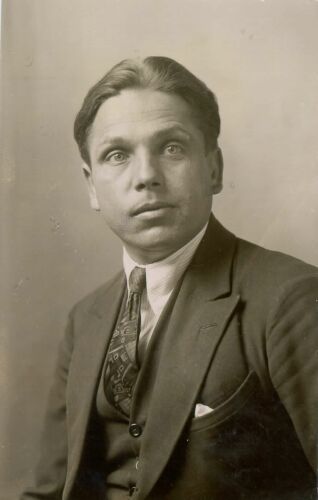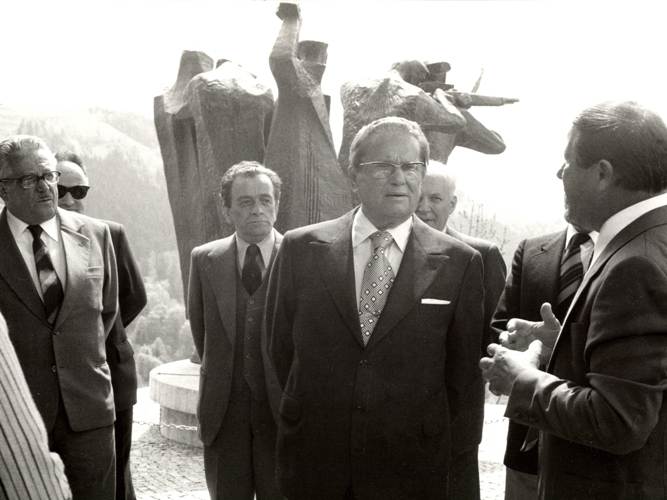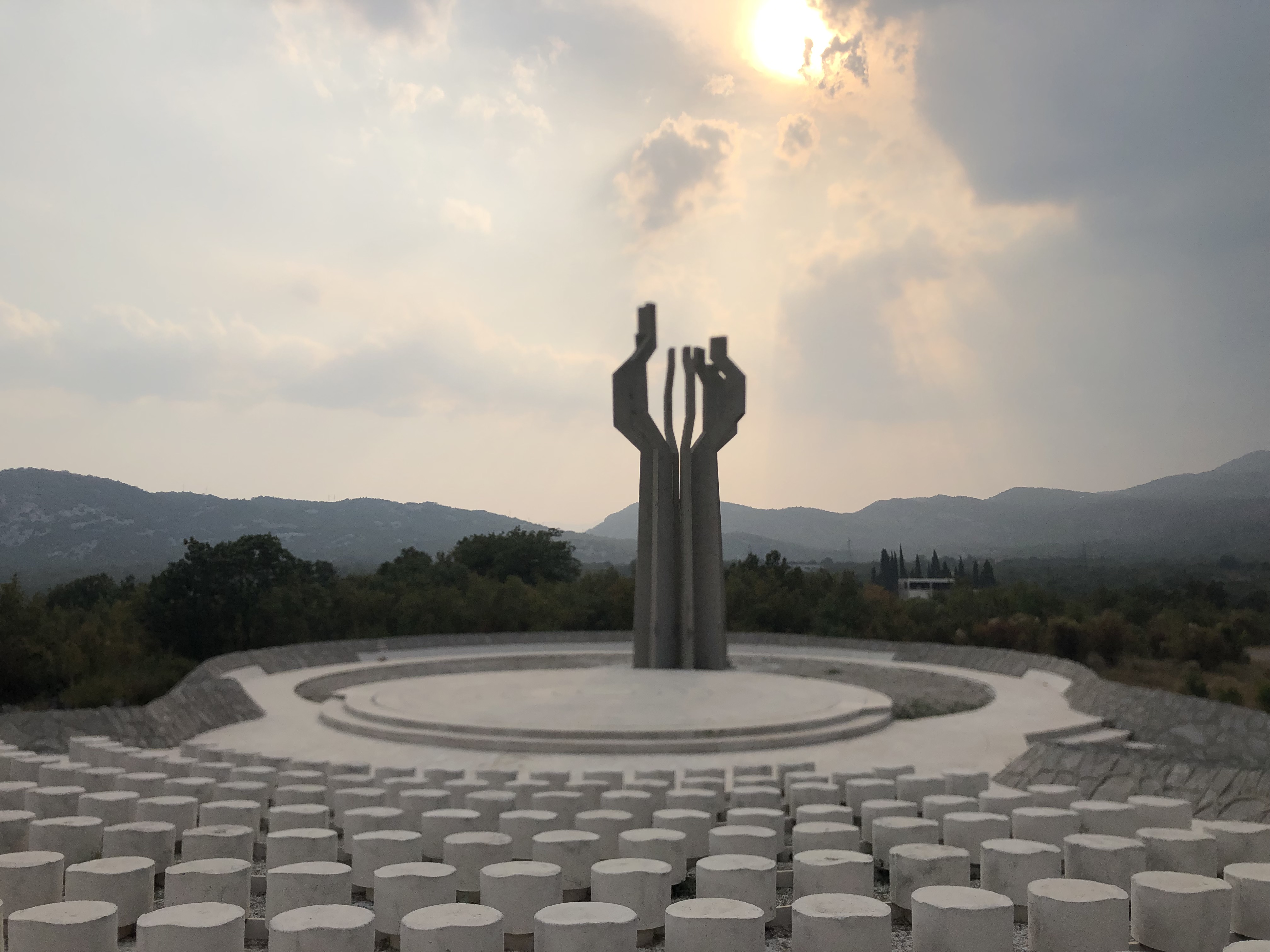|
List Of World War II Monuments And Memorials In Slovenia
List of World War II monuments and memorials in Slovenia represent Yugoslav monuments and memorials built on the territory of the present day Slovenia. History The Yugoslav authorities established several memorial sites between 1945 and 1960, though widespread building started after the founding of the Non-Aligned Movement. Yugoslav president Josip Broz Tito commissioned several memorial sites and monuments in the 1960s and 70s dedicated to World War II battle, and concentration camp sites. They were designed by notable sculptors, including Dušan Džamonja, Vojin Bakić, Miodrag Živković, Jordan and Iskra Grabul, and architects, including Bogdan Bogdanović, Gradimir Medaković. After Tito's death, a small number was built, and the monuments were popular visitor attractions in the 1980s as patriotic sites, and since the Yugoslav Wars and the dissolution of Yugoslavia, most of the sites are abandoned and have lost their importance. The list houses monuments and memorials ... [...More Info...] [...Related Items...] OR: [Wikipedia] [Google] [Baidu] |
Slovenia
Slovenia ( ; sl, Slovenija ), officially the Republic of Slovenia (Slovene: , abbr.: ''RS''), is a country in Central Europe. It is bordered by Italy to the west, Austria to the north, Hungary to the northeast, Croatia to the southeast, and the Adriatic Sea to the southwest. Slovenia is mostly mountainous and forested, covers , and has a population of 2.1 million (2,108,708 people). Slovenes constitute over 80% of the country's population. Slovene, a South Slavic language, is the official language. Slovenia has a predominantly temperate continental climate, with the exception of the Slovene Littoral and the Julian Alps. A sub-mediterranean climate reaches to the northern extensions of the Dinaric Alps that traverse the country in a northwest–southeast direction. The Julian Alps in the northwest have an alpine climate. Toward the northeastern Pannonian Basin, a continental climate is more pronounced. Ljubljana, the capital and largest city of Slovenia, is geogr ... [...More Info...] [...Related Items...] OR: [Wikipedia] [Google] [Baidu] |
Lojze Dolinar
Lojze Dolinar (April 19, 1893 – September 9, 1970) was a Slovenian sculptor recognized for his impact on local and global 19th and 20th century art. When he moved to America he worked in architectural plastic art and thereafter in antique and modern art. In 1931 he went to Belgrade and between World War I and World War II he became one of the most sought-out monument sculptors. In 1946 he joined the Belgrade Fine Arts Academy and three years later got a professorship there. Among others he was taught by Alojzij Repič and worked with Jože Plečnik. Sculptures # The Blind One # Portrait of Rihard Jakopič # Dr. Janez Evalengelist Krek tombstone # Statues in Slovenian Square # 2 Calvary monuments in Ljubljana # Ivan Hribar, Sphinx and Joy # Fallen student-soldiers monument # Revolution Monument, Kranj # Moses # A Shepherd In 1966 his works were showcased in a Kranj special museum at the Town Hall. In 1969 he received the Prešeren Award The Prešeren Award ( sl, Prešernova n ... [...More Info...] [...Related Items...] OR: [Wikipedia] [Google] [Baidu] |
Ive Šubic
Ive Šubic (23 April 1922 – 29 December 1989) was a Slovene painter, graphic artists and illustrator. Šubic was born in the village of Hotovlja near Poljane above Škofja Loka in 1922. He enrolled in the Zagreb Academy of Arts in 1940, but his studies were interrupted by the Second World War. He joined the partisans in 1941 and participated in the Battle of Dražgoše, the monument to which he later participated in designing. After the war he studied at the Academy of Fine Arts in Ljubljana under Gojmir Anton Kos and Božidar Jakac. He graduated in 1948. He is known for his paintings, linocuts and other prints, illustrations and murals. He died in Škofja Loka in 1989. In 1968 he won the Prešeren Foundation Award for the exhibition of his art in the Škofja Loka Museum. In 1979 he won the Grand Prešeren Award for his creative achievements. He also won the Levstik Award for his illustrations five times, in 1949, 1951, 1967 (with Jože Ciuha), 1969 and 1971. The ''Ive � ... [...More Info...] [...Related Items...] OR: [Wikipedia] [Google] [Baidu] |
Boris Kobe
Boris Kobe (9 October 1905 – 3 May 1981) was a Slovene architect, painter, and designer. Kobe was born in Ljubljana in 1905. He studied art at the Department of Architecture at what was then the University of Ljubljana Technical Faculty under Jože Plečnik and graduated in 1929. During the Second World War he was imprisoned in the Allach concentration camp. After the war he worked as an architect, painter, and designer in Ljubljana. He died in 1981. In the early 1940s, he arranged the area around Tivoli Pond and the children's playground next to it. Awards He received the Prešeren Award for his architecture, paintings, and designs in 1977. He won the Levstik Award for his illustrations of Ivan Tavčar Ivan Tavčar () (28 August 1851 – 19 February 1923) was a Slovenian writer, lawyer, and politician. Biography Tavčar was born into the poor peasant family of Janez and Neža née Perko in the Carniolan village of Poljane near Škofja Loka ...'s ''Visoška kronika'' ... [...More Info...] [...Related Items...] OR: [Wikipedia] [Google] [Baidu] |
Stojan Batič
Stojan Batič (2 June 1925 – 17 September 2015) was a Slovene sculptor. Mostly a figurative artist, he is particularly known for his sculptures exhibited in many public places in Slovenia. Life Batič was born in a working-class family in Trbovlje, a mining town in central Slovenia, then part of the Kingdom of Serbs, Croats and Slovenes. As a teenager, he worked in the local coal mine. At the age of 19, he joined the partisan resistance and fought the invading Nazi German forces. After World War II, he was the first to enroll at the newly established Academy of Fine Arts at the University of Ljubljana, where he studied sculpture under Boris Kalin and Frančišek Smerdu. In 1957, he received a scholarship, which enabled him to study in Paris with the sculptor Ossip Zadkine. Batič lived and worked in Ljubljana. In 1995, he had a show at Ljubljana City Gallery. In 2015, the Jakopič Gallery held a retrospective exhibition of his work under the title "The Man and The Myth" ... [...More Info...] [...Related Items...] OR: [Wikipedia] [Google] [Baidu] |
Dražgoše
Dražgoše (; german: Draschgosche) is a village in the Municipality of Železniki in the Upper Carniola region of Slovenia. The village lies on the southern slopes of the Jelovica Plateau. The settlement consists of three hamlets: Pri Cerkvi, Na Pečeh, and Jelenšče. Name Dražgoše was attested in written sources in 1291 as ''Drasigos'' (and as ''Drasigvs'' in 1318 and ''Draschigosch'' in 1481). The name is derived from ''*Dražigosťane'', a plural demonym derived from the Slavic personal name ''*Dražigostь'', referring to a local resident. In the past it was known as ''Draschgosche'' in German. History Dražgoše was already inhabited in prehistoric times, as evidenced by archaeological excavations at a hillfort in the hamlet of Jelenšče. The site has visible defensive trenches. A school was established in Dražgoše in 1894, replacing instruction that had previously been offered at the sexton's residence in the village since 1889. What is now Dražgoše was originally ... [...More Info...] [...Related Items...] OR: [Wikipedia] [Google] [Baidu] |
Edo Mihevc
Edo ( ja, , , "bay-entrance" or "estuary"), also romanized as Jedo, Yedo or Yeddo, is the former name of Tokyo. Edo, formerly a ''jōkamachi'' (castle town) centered on Edo Castle located in Musashi Province, became the ''de facto'' capital of Japan from 1603 as the seat of the Tokugawa shogunate. Edo grew to become one of the largest cities in the world under the Tokugawa. After the Meiji Restoration in 1868 the Meiji government renamed Edo as ''Tokyo'' (, "Eastern Capital") and relocated the Emperor from the historic capital of Kyoto to the city. The era of Tokugawa rule in Japan from 1603 to 1868 is known eponymously as the Edo period. History Before Tokugawa Before the 10th century, there is no mention of Edo in historical records, but for a few settlements in the area. Edo first appears in the Azuma Kagami chronicles, that name for the area being probably used since the second half of the Heian period. Its development started in late 11th century with a branch of the c ... [...More Info...] [...Related Items...] OR: [Wikipedia] [Google] [Baidu] |
Boris Kalin
Boris Kalin (24 June 1905 – 22 May 1975) was a Slovene sculptor. He mainly created classical figures, public monuments, and nudes. Some of his sculptures are kept at Brdo Castle as part of its collection of modern Slovene art. Biography Kalin was born in Solkan, which was then a suburb of the Austro-Hungarian town of Gorizia and is now part of Nova Gorica, Slovenia. He attended the technical secondary school in Ljubljana and continued his studies between 1924 and 1929 at the Zagreb Academy of Fine Arts with the professors Rudolf Valdec, Frano Kršinić, Ivo Kredić, and Ivan Meštrović. From 1945 to 1970, Kalin taught sculpture at the Academy of Fine Arts in Ljubljana; he was also its dean for two terms. He taught many younger colleagues that became prominent European artists. Kalin was one of the few Slovene sculptors to master stone carving. In 1953 he became a full member of the Slovenian Academy of Sciences and Arts. He died in Ljubljana. His younger brother Zdenko was a ... [...More Info...] [...Related Items...] OR: [Wikipedia] [Google] [Baidu] |
Kropa
Kropa () is a settlement in the Municipality of Radovljica in the Upper Carniola region of Slovenia. Name The settlement was first attested in 1498 as ''Chropp'' or ''Krupp''. It is believed to derive from the identical hydronym (now Kroparica Creek), first attested in 1481 as ''pach Khrappa'' or ''Khroppa'', which has its source at Kroparica Spring ( sl, Izvir Kroparice) above the settlement. The hydronym is derived from the Slovene common noun ''kropa'' 'powerful spring'. Metalworking It is known for its traditional smithies, which produce a variety of decorative metal fittings. There is an iron forging museum in Kropa. Metalworking has an ancient tradition in Kropa, with evidence of metalworks from Celtic times in the wider area and the earliest furnaces actually in Kropa from the 14th century onwards. Churches There are two churches in Kropa: St Leonard's Church and a church dedicated to the Virgin Mary. Saint Leonard's Church is originally a Gothic structure that was expa ... [...More Info...] [...Related Items...] OR: [Wikipedia] [Google] [Baidu] |
Spomenik Lipnica Pri Kropi
The authorities of the Socialist Federal Republic of Yugoslavia established many World War II memorials during its existence. Several memorial sites were established between 1945 and 1960, though widespread building started after the founding of the Non-Aligned Movement. Yugoslav president Josip Broz Tito commissioned several memorial sites and monuments in the 1960s and 1970s dedicated to World War II battles, and Nazi concentration camp sites. They were designed by notable sculptors, including Dušan Džamonja, Vojin Bakić, Miodrag Živković, Jordan and Iskra Grabul, and architects, including Bogdan Bogdanović and Gradimir Medaković. After Tito's death, a small number were built, and the monuments were popular visitor attractions in the 1980s as patriotic sites, and since the Yugoslav Wars and the dissolution of Yugoslavia, the sites are mostly abandoned. In Slovenia, World War II Veteran Organisation and its branches yearly hold many commemorative events in regard with th ... [...More Info...] [...Related Items...] OR: [Wikipedia] [Google] [Baidu] |




